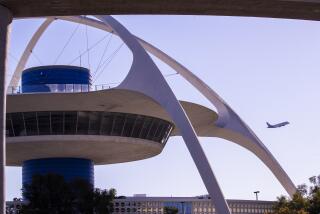FAA Heeds Terror Warning, Bars Flight Near Nuclear Plants
- Share via
Responding to U.S. Atty. Gen. John Ashcroft’s warning of possible terrorist attacks this week, the Federal Aviation Administration on Tuesday banned private planes from flying near nuclear sites, including the San Onofre power plant just south of San Clemente.
Planes are prohibited from flying within 18,000 feet above or 10 nautical miles (11.5 miles) away from 86 nuclear sites in the country. The restrictions should not affect commercial aircraft, which fly much higher.
“The reason this was initiated now is because of renewed concerns” about possible terrorist activity, said Jerry Snyder, spokesman for the FAA’s Western-Pacific region, based in Hawthorne. “As long as we are in this state of security, there is a chance that these restrictions will be either extended or increased, depending on what the perceived threat might be.” The new rules are due to expire Nov. 7.
Other California sites affected include the Diablo Canyon power plant near San Luis Obispo and the Sandia and Livermore national laboratories near Livermore.
The Aircraft Owners and Pilots Assn. of Frederick, Md., said the restrictions will effectively close 454 airport facilities--including heliports and private airports--across the nation. It was unknown whether any of those are in Southern California.
“Are we happy with this? . . . Absolutely not!” wrote association President Phil Boyer in a statement on the group’s Web site. “However, it could have been much worse.”
He noted that the FAA could have grounded all general aviation aircraft.
George McJimsey, president of Pinnacle Aviation Academy in Carlsbad, said that in Southern California the new rules will mean that pilots traveling from Los Angeles to San Diego may have to go far offshore or inland.
“It’s a little bit out of the way. It’s a little bit inconvenient,” he said, but it’s “doable in the interest of national security.”
In addition to the air restrictions, the U.S. Nuclear Regulatory Commission called on power plants to increase perimeter security and coordinate efforts with local, state and federal law enforcement, said Breck Henderson, an NRC spokesman in Arlington, Texas.
Ashcroft’s warning prompted governors in Arizona, Arkansas and Louisiana to call out the National Guard to protect nuclear plants in those states. Plants in New York, New Jersey and Massachusetts were already protected by National Guard troops.
California Gov. Gray Davis has not taken such action, but his spokesman Steve Maviglio said the issue is being reviewed.
San Onofre spokesman Ray Golden said additional security has been imposed since Monday’s announcement. He declined to detail it for security reasons.
Some nuclear plants that are near airports have been built to withstand the impact of a small plane. The NRC is conducting tests to see what would happen if a commercial jet slammed into a reactor. San Onofre officials have said that the plant could withstand a small plane but that it was not designed to hold up against a larger aircraft.
Air traffic controllers and the North American Air Defense Command will monitor the no-fly zones, said FAA spokesman Mike Fergus.
If a plane flies into a restricted zone, officials will try to establish radio contact and, if necessary, send military jets to escort it out of the area--or shoot it down.
More to Read
Sign up for Essential California
The most important California stories and recommendations in your inbox every morning.
You may occasionally receive promotional content from the Los Angeles Times.














